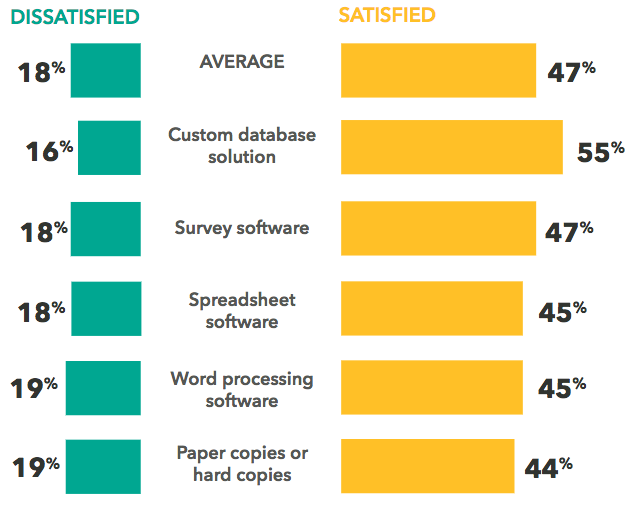When non-profit organizations set out to measure their outcomes and evaluate their programs, data is precious. They typically turn to a variety of data storage methods, but some are more effective than others. Which storage methods is the industry most satisfied with, and which just aren’t working?
A new survey gives us a picture.
Non-profit consultant Innovation Network surveyed 1,125 US-based nonprofit organizations in 2016, and the results paint a clearer picture about how non-profits are storing the precious data used to measure their outcomes.
Innovation Network discovered that nonprofits used multiple data storage methods and at least 85% of them stored data in three or more of these methods. These data storage options include: spreadsheet software (92%), word processing software (82%), paper or hard copies (82%), survey software (60%) and as a database (58%).
Spreadsheets, word processing files, and hard copies were the most popular methods of data storage.
But what stood out in the Innovation Network survey was that nonprofits observed a noticeable level of dissatisfaction with the most popular ways of data storage. The only data storage method that tallied a satisfaction rating above 50% was the use of a custom database solution (55% satisfaction rate). The custom database option also registered the lowest dissatisfaction rating at 16%.

Credit: 2016 State of Evaluation report
It makes sense why a custom database solution is preferable. Spreadsheets and word files could be cumbersome to access online. And with paper copies, it is simply impossible. A custom database allows a nonprofit to collect, classify, store, modify, delete, and access data so much more easily. Custom databases are also much more secure than other options.
A blog post from Ayoka, an enterprise application services company, outlines the benefits of a custom database storage solution:
Custom database development services are specific to each client. These services don’t focus on only one type of business. They cover a wide range of businesses and are capable of building an array of applications to fit anyone’s business objectives.
[…]
With a customized database, you always have room for modification, allowing for future changes to occur. However, the custom software usually requires the source code prior to adding future modifications to the system. Because your business is bound to grow or change, you need your software to reflect that in order to be successful. You want software that changes and evolves with your company.
While there is no doubt that a custom database solution would be excellent for most nonprofits, such a custom database may be too expensive or too technical for some. It would take some work to reconcile the cost-benefit scenarios for these nonprofits.



